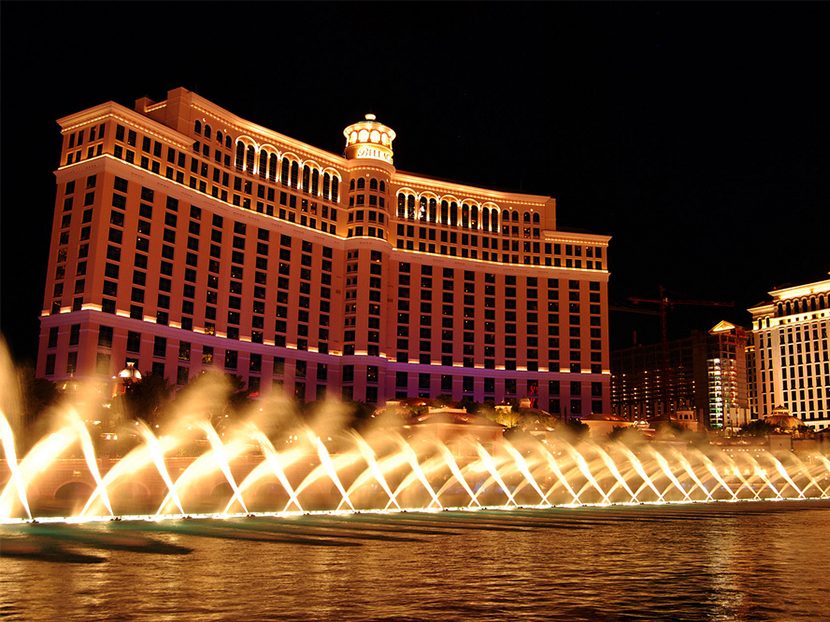An Engineering Marvel
The famous fountain at the Bellagio proves to be a feat of engineering.

Last month, I had the good fortune to take a short vacation in Las Vegas. I stayed in the newly developed area of City Center, specifically a hotel called Vdara. I liked this hotel because it doesn’t have a casino. I am not a gambler, so I don’t like having to traipse through a stinky, dark casino every time I come and go from the hotel. However, this particular hotel is connected to the Bellagio, a very well-known casino that you have probably heard of.
One afternoon I decided to go to the Bellagio to have lunch, since there is a much larger selection of restaurants there than at Vdara. It was a beautiful day, and I was lucky enough to sit outside at a restaurant called Olive. My table had the closest seats in proximity to the internationally famous fountain at the Bellagio. Most of you are probably familiar with it.
The fountain is spectacular to say the least — an engineering marvel. The true cost of the fountain was estimated between $40 million and $75 million. Steve Wynn, the casino developer, was once quoted as saying that he started out with a hotel with a water feature in front, and he ended up with a water feature with a hotel behind it. That’s quite an accolade for the fountain!
As we finished our lunch, at 3 p.m. sharp the fountain exploded with its first display of the day. It performs its dance of water choreographed to music every 20 to 30 minutes depending on the day. I’ve seen the fountain do its thing before, but this close-up perspective really emphasized the power of the water. The show included two songs, the first was the National Anthem and the second was from Andrea Bocelli.
The fountain was designed from 1995 to 1998 when it opened. The design and construction was done by WET Design of Sun Valley, California, but I believe at the time they were based in Universal City. (I interviewed with them for a job before moving to California, but that didn’t come to fruition). The project was so successful that adjacent properties market their rooms as “having a view of the Bellagio fountain,” an unusual approach, to bill the popularity of the adjacent property to sell your own.
The fountain has over 22 million gallons of water (recycled of course), and the display shuts down on windy days to preserve the precious water supply. Inside the fountain pool are more than 200 robotic “oarsmen” that move to the music and make the water swirl and dance up to 77 feet into the air. Unique about the oarsman is the fact that they have no piping connected to them. Each robotic water element draws its water supply directly from the pool and shoots it into the air. There are no central pumps or piping connected to these little robots — they are each standalone. They were designed and built specifically for this project, and they were the first of their kind.
To maintain these delicate oarsmen the hotel has a team of 30 engineers, all registered divers, with myriad rooms to repair or make parts when required. Other rooms house pumps, compressors, water tanks and air receivers. There’s even a barge and landing dock to navigate the pool with equipment whenever and wherever necessary. The engineers have special dive suits custom designed with Kevlar to give them the underwater mobility they need when they work.
The oarsmen are only one of several elements of the water feature, and while they are soft and lovely in their display, in my opinion they are not as impressive as the various “shooters” that comprise the rest of the display.
First among the shooter class are the 798 mini-shooters that shoot burst of water into the air 100 feet high. Each shot is followed by a crack of compressed air that is released after each one, stopping the jet of water and producing mist at the base of the jet. The sound is easily mistaken as fireworks, but it is actually a byproduct from the creation of each water jet.
Still more impressive are the 192 super-shooters that produce jets of water 240 feet high with a proportionally louder crack of compressed air after each shot.
For the grand finale of each song, there are 16 extreme-shooters that produce jets of water 460 feet high with a thunderous boom at the end of each one.
Powering these jets of water from the shooters cannot be done efficiently using pumps alone — that would require 60,000 HP when you combine the flow and pressure required. Instead, each super-shooter has a reservoir of water in a 12-foot tall tank, 12-inches in diameter, connected at its base to a 200 psi, 60-gallon air receiver. Air is delivered by precisely controlled valves to fire the water into the air at precisely the right moment. After each shot the super-shooter tank has to be replenished, so they can only fire so frequently. A compressor runs continuously during the show to replenish the 200 psi air receivers. I imagine a great deal of engineering was required to control the water hammer associated with these super-shooters. Think of the racket created when you bleed air from your own faucet at home, and imagine that with 100 gpm and 200 psi behind it. Quite a remarkable achievement to say the least!
Complementing this vast array of oarsman and shooters is a fog system that operates at 2,000 psi and produces a fog that captures light and decorates the base of the display in a white cloud. Each fog emitter flows 0.05 gpm through an orifice just 0.006” in diameter. There are 5,000 of them at the Bellagio. Consistent with everything else, nothing goes understated there!
Of course, at night all of this water art must be illuminated. There are 5,000 lights that highlight the display, and those lights are in constant need of new bulbs. I don’t know if they use LED technology or not. Probably not originally, but they may have been converted over the years. The lights, like everything else, are choreographed to the music to enhance the visual effect of the fountain.
While each display is conducted to two or three songs, there are 29 songs in the full repertoire of the fountain. It is tempting to stay there all day to see every song in the arsenal, but that of course becomes impractical.
I would love to take a tour of the mechanical rooms that serve the fountain. I don’t know if the hotel ever does this. Perhaps some of you readers out there have seen these hidden spaces? If so, I would love to hear about them.





